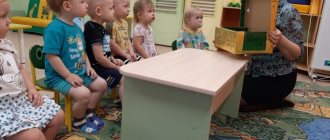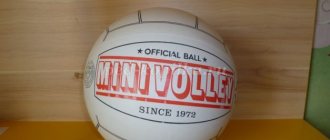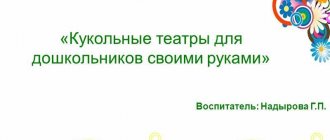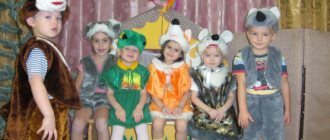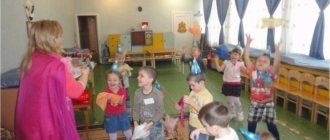Work program of the theatrical activities club in the 2nd junior group
March
1.I. "Granny's Fun"
II. "Let's bake pies"
To form a sustainable interest in oral folk art, to create a desire to listen to nursery rhymes, songs, to observe the actions of the teacher, to repeat the movements shown by the teacher.
“Granny”
for the teacher
2. “How I love my little cow”
II. “Girls and boys”
(dance to the text of the nursery rhyme)
Introduce children to the character of the puppet
theater
, support the desire to communicate with the toy, develop emotional responsiveness, a sense of rhythm. Cow toy
(bibabo)
3.I. "The sun is shining through the window"
II. “Sunshine and Rain”
(adventure game)
Encourage children to sing along with individual words of the song, accompanying the singing with movements, to create a joyful mood. Attributes for the outdoor game
“Sunshine and Rain”
4.I. "Zayushkina's hut"
II. “Three Merry Brothers”
(German folk song with movements)
Encourage children to carefully follow the development of action in a fairy tale, create a desire to sing along with individual words of the song, watching the action of the teacher with a toy Tabletop
theater
April
1.I. "Our ducks in the morning"
II. “Topotushki”
(a nursery rhyme)
Continue to introduce children to
the theater
, create a desire to take part in the performance, repeating the actors’ remarks after the teacher. Develop the perception of music through movements Mask hats for dramatization
2.I. "The Snow Maiden and the Fox"
II. “Stepan walked through the forest...”
(round dance)
Continue to introduce children to puppetry techniques, develop the ability to empathize with fairy tale characters, encourage children’s desire to participate in games with musical accompaniment. Flannelograph
3.I. "Masha is having lunch"
II. “Vasya the little goose ”
(folk game)
Continue to introduce children to puppeteering techniques, develop children’s speech, achieving clear pronunciation, and expand their vocabulary.
Improve children's motor activity in games with poetic accompaniment Toy Theater
4.I. “A beautiful hen lived with me”
.
II. “The chicken went out for a walk”
(dramatization of the song)
Encourage children’s desire to participate in creating a playful image with the help of movements, improve the motor activity of children Chicken toy, chicken hats.
May
1. “Who said meow?”
. Suteev. Teach children to perceive the content of a fairy tale,
carefully follow the development of the plot, imitate the voices of the Flannelograph characters.
2. "The Tale of the Stupid Mouse"
.
S. Ya. Marshak Introduce children to the new theater
, teach to listen carefully to the work, observing the actions of the teacher.
Table theater on mugs
.
3. "About shoes"
. 4. “Who came to visit us?” Involve children in participating in the play, teach them to imitate the movements of animals, distinguish sounds by pitch, rhythm (a bear walks, a hare jumps, a fox runs) Tambourines. Three different hats: bear, fox. hare)
Theater in the second junior group
Theatrical activities in kindergarten
Author: Filimonova Svetlana Grigorievna, teacher of the State Budgetary Educational Institution Secondary School No. 319, Moscow, preschool department. Description of the material : I offer material on conducting theater week in the 2nd junior group. This material will be useful to kindergarten teachers. I work in the 2nd junior group. Since the leading type of activity for children is play, an important role belongs to the puppet theater. It entertains and educates children, develops their imagination, teaches them to empathize with what is happening, creates an appropriate emotional mood, liberates the child, and increases his self-confidence. Children really love theatrical games, in which they can transform into their favorite characters, dramatize familiar fairy tales and admire theatrical performances performed by adults and older children. Therefore, I decided to take an active part in the theater week, which took place in our garden from March 24 to March 28 In 2014, theater week took place in our garden. Throughout the week, work was carried out to familiarize children with theatrical activities. At the first lesson, I told the children what theater is, how to behave in the theater. And for parents, I developed a reminder for the first trip to the theater with their children. Then, together with the teachers of another group, we staged the fairy tale “Kolobok” and showed it to the children.
During appliqué classes with children, we made a cut-out appliqué based on the fairy tale: “Turnip.” At home, the children and their parents made little books based on Russian folk tales.
And throughout the week I made different types of theaters (finger theater from papier-mâché, theater from CDs, shadow theater, theater on clothespins, rag dolls, theater from wooden shovels), and the children watched and helped as much as possible. I also made a card index of theatrical games and physical education lessons. In our corner there are several types of theater made with your own hands: All this is very easy to do, beautiful and the children are delighted. They really like to play. And at the end of the week we had a theater corner competition. Our theater took 1st place.
We recommend watching:
Theatrical activity in kindergarten DIY hat. Master class with step-by-step photos Scenario of a theatrical performance for children with disabilities (CP) Theatrical entertainment in the middle group. Scenario
Similar articles:
Dramatization of Chukovsky's fairy tale The Fly Tsokotukha for children 5-7 years old
Dramatization of a fairy tale in the senior group “About the Little Mouse”
Theater performance in the senior group. Fox-sister and gray wolf
Theater quiz for the senior group
Game performance in kindergarten. Middle - senior group
Project "Theater for Kids"
Age group: second youngest group (3-4 years).
Project goal: To introduce children to theatrical culture.
Relevance:
Today, when the problem of preschool education and upbringing is being widely and fundamentally solved and the tasks facing teachers of preschool educational institutions are becoming more complex, the task of introducing children to theatrical activities from a very early age remains very important.
Creative activity and the development of human creative abilities are an integral part of the socio-economic and spiritual directions of the modern social structure. The word “creativity” in the social sense means to search for, to depict something that has not been encountered in past experience, individual and social. Creative activity is an activity that gives birth to something new; the free art of creating a new product that reflects the personal “I”. Creativity is not only the creation of something new in material and spiritual culture, but also a person’s improvement of himself, primarily in the spiritual sphere.
Children's creativity is one of the pressing problems of preschool pedagogy and child psychology. It was studied by L. S. Vygotsky, A. N. Leontiev, L. I. Venger, N. A. Vetlugina, B. M. Teplov, O. M. Dyachenko, A. I. Volkov and many others.
Theatrical activity is the most common type of children's creativity. It is close and understandable to the child, lies deeply in his nature and is reflected spontaneously, because it is connected with play. The child wants to translate any of his inventions, impressions from the life around him into living images and actions. Entering the character, he plays any role, trying to imitate what he saw and what interested him, and receiving great emotional pleasure.
Theater activities help develop the child’s interests and abilities; contribute to overall development; manifestation of curiosity, desire to learn new things, assimilation of new information and new ways of action, development of associative thinking; perseverance, dedication to the manifestation of general intelligence, emotions when playing roles. In addition, theatrical activities require the child to be decisive, systematic in work, and hardworking, which contributes to the formation of strong-willed character traits. The child develops the ability to combine images, intuition, ingenuity and ingenuity, and the ability to improvise. Theatrical activities and frequent performances on stage in front of audiences contribute to the realization of the child’s creative powers and spiritual needs, emancipation and increased self-esteem. Alternating the functions of performer and spectator, which the child constantly takes on, helps him demonstrate to his comrades his position, skills, knowledge, and imagination.
Exercises for the development of speech, breathing and voice improve the child’s speech apparatus. Completing game tasks in the images of animals and characters from fairy tales helps to better master your body and understand the plastic possibilities of movements. Theatrical games and performances allow children to immerse themselves in the world of fantasy with great interest and ease, and teach them to notice and evaluate their own and others’ mistakes. Children become more relaxed and sociable; they learn to clearly formulate their thoughts and express them publicly, to feel and understand the world around them more subtly.
The love for theatrical creativity, the desire to pass this love on to children, the desire to make a child’s life happier and his inner world richer through theatrical skill, became the reference point for the creation of this project.
Project objectives:
- Create conditions for the development of children's creative activity in theatrical activities.
- Teach children various means of improvisation.
- To form children's ideas about various types of theater and theatrical genres.
- Provide conditions for the relationship between theatrical and other activities.
- Involve children in dramatizing small works.
- Learn to convey the habits of animals in movements, create playful images, instill communicative qualities, and the ability to move in the character of music.
- Develop children's dialogical speech.
- Learn to read individual lines of dramatization expressively.
- Form the need to share your impressions with the teacher and parents.
10. Create conditions for joint activities of children and adults.
Project participants:
- Pupils of the group.
- Group teacher.
- Parents of group children.
- Musical director.
Stages and timing of the project: March (3-4 weeks) from March 14 to March 25, 2021.
Expected results:
Child development in all areas of educational fields.
Significant expansion of children's ideas about theatrical culture.
Creating a subject environment that promotes the development of theatrical culture in children.
Forms of working with children:
- organization of educational, developmental and creative activities;
- organizing joint events with parents;
- organization of theater evenings (showing fairy tales and performances);
Theater classes in the second junior group.
During theater classes, children learn the simplest techniques for controlling tabletop theater puppets. You can suggest coming up with small stories that happen with the toy, so that the child can compose dialogues himself and find expressive intonations. At the same time, you can provide assistance with leading questions, without providing a ready-made role model. No matter how primitive the stories written by children are, encouragement is necessary. The child must be encouraged to want to play with the doll. Acting out written fairy tales spiritually liberates the child and you need to pay attention to this. In theater classes, it is necessary to create an atmosphere of goodwill, mutual trust, and respect for each other. A child can only create when he feels the friendly attitude of his peers and adults.
In the second junior group, great importance is given to working on sketches. This is a kind of school that helps children learn the secrets of controlling theatrical puppets and the basics of acting. Children learn to express their feelings and understand the feelings of other people through play. This will help them avoid difficulties in communicating with peers and adults. Working on sketches develops the child and gives him the necessary skills to participate in puppet and other performances. Only by creating an atmosphere of creative cooperation can we begin staging the play. In the second younger group, you can act out well-known Russian folk tales with tabletop dolls: “Hen-Ryaba”, “Masha and the Bear”, “Bull-Tar Barrel”, “Zayushkina’s Hut”. Here you can also invite children to come up with a dialogue themselves. By the end of the second junior group, children should already have mastered the skills of controlling tabletop dolls, can fully concentrate their attention on the doll, and listen carefully to their partner. Children can also compose a short fairy tale on their own.
Forms of interaction with families of pupils:
- Joint production of toys and aids for organizing a subject-development environment.
- Involving parents in joint events.
- Open screenings of classes and theatrical performances.
- Consulting parents on leading and current issues.
- Organization of visits to cultural sites and cultural events.
Final event (form, name): dramatization of the fairy tale “Turnip” for parents
Main stages of the project:
Stage 1
Preliminary work
- Studying methodological literature.
- Drawing up a program of activities to implement the project’s objectives.
- Acquisition of didactic material to create a subject-development environment
Stage 2
Main job
The project is focused on the comprehensive development of the child’s personality, taking into account his individuality. It systematizes the means and methods of theatrical and play activities.
The content of theatrical activities includes:
— watching puppet shows and conversations about them;
- dramatization games;
— correctional and educational games; diction exercises (articulation gymnastics);
— tasks for the development of speech intonation expressiveness;
- transformation games (“learn to control your body”), imaginative exercises;
— rhythmoplasty;
— finger play training for the development of hand motor skills;
- preparation (rehearsals) and performance of various fairy tales and dramatizations;
Song creativity, playing children's musical instruments, dance creativity, holidays, and leisure activities are planned and carried out together with the music director during music classes and in free time.
Theater classes 1-2 times a week. In the schedule of classes it is planned in the first half of the day.
The material for classes is taken from the book by N.F. Sorokina “Scenarios for theater classes”, Moscow, Arkti Publishing House, 2007.
Stage 3
Final work
The content of the work:
— Monitoring the implementation of project tasks.
— Final event. Children's dramatization of the fairy tale "Turnip". Showing the performance to parents.
| Educational area/event | Content | Familiarization with works of fiction | Expected Result | |||
| Stage 1 - organizational and preparatory 3 days | ||||||
| Study of regulatory documentation and methodological literature on this topic |
| |||||
| Project development | Determining the topic of the project, its goals, objectives, relevance, stages and deadlines for implementation, indicators for achieving the project goal, forecasting the expected results. Preliminary work with children's parents. | |||||
| Creating a subject-development environment | To successfully implement the project's objectives, it is necessary to create an appropriate subject-development environment.
| By participating in theatrical games, children become participants in various events from the lives of people, animals, and plants, which gives them the opportunity to better understand the world around them. At the same time, theatrical play instills in the child a sustainable interest in his native culture, literature, and theater. The educational significance of theatrical play is also enormous. Children develop a respectful attitude towards each other. They learn the joy associated with overcoming communication difficulties and self-doubt. Children’s enthusiasm for theatrical play, their inner comfort, relaxedness, easy, non-authoritarian communication between an adult and a child, the “I can’t do it” complex disappears almost immediately | ||||
| Stage 2 – implementation (5 days) | ||||||
| 1 day - work with children | ||||||
| Speech development |
| Russian folk tale "Turnip" | Children will remember a familiar fairy tale, learn to express emotions with the help of facial expressions and gestures, the prerequisites will be created for the development of dialogic speech; a stable interest in theatrical activities will develop. | |||
| GCD “Journey to the fairy tale “Turnip”” (Appendix No. 1) | ||||||
| Conversation with children “Going to the theater with parents” |
| Children's knowledge about theater and theatrical performances is systematized. | ||||
| Reading fiction. Reading of V. Berestov’s poem “Petrushka” (Appendix No. 3) | Learn to listen carefully and interestedly to a story | Children listen carefully to the story. | ||||
| Didactic game "Guess by the sound" (Appendix No. 6) | Develop children's auditory attention. | Children will learn to distinguish musical instruments by sound. | ||||
| Examination of theatrical sets “Tabletop Theatre”, “Puppet Theatre”, |
| Reading nursery rhymes “Cucumber, cucumber”, “Vanya walks” | ||||
| Artistic and aesthetic development: | Encourage children to improvise simple dance movements to a variety of music | “Dance of Parsley” (music by D. Kabalevsky), | Children will learn to improvise simple dance movements to a variety of music. | |||
| NOD “Dance creativity. Dance improvisations: | ||||||
| Physical development |
| Learning words from the game | Children will learn to perform movements in accordance with the text | |||
| Outdoor game while walking (Appendix No. 7) | ||||||
| Physical education (Appendix No. 7) | Learn to perform movements in accordance with the text. | Learning words from the game | Children will learn to perform movements in accordance with the text | |||
| Interaction with families of pupils | ||||||
| Promotion “Costume for a fairy tale hero” | Involve parents in setting up a theater corner in the group and in sewing costumes for theatrical performances. | The parents of the group actively responded to the action. | ||||
| Day 2 - work with children | ||||||
| Artistic and aesthetic development of NOD |
| Reading the fairy tale "Kolobok" | Children will remember a familiar fairy tale and learn to convey the image of their favorite characters in their drawing. | |||
| Drawing “Kolobok rolled along the path” | ||||||
| Speech development |
| Reading of A. Barto’s poem “Bear” | Children will learn to accompany their actions with words. | |||
| Didactic game “Let’s collect Bear for a walk” (Appendix No. 6) | ||||||
| Finger gymnastics “Flower and Butterfly” |
| Physical education text (Appendix No. 7) | Fine motor skills of the hands develop. | |||
| Social and communicative development: | Teach children the rules of behavior in public places (theater) | Reading an excerpt from G. Shalaeva’s book “Rules of conduct for well-mannered children. Theater" | Children will learn proper behavior in the theater. | |||
| Conversation “Rules of conduct in the theater” | ||||||
| Role-playing game using a rubber toy theater "Meeting in the forest". (written by children) | Involve children in writing short fairy tales and stories and acting them out. | Children will try to compose a story on their own, focusing on their imagination, and play it out with the help of toys. | ||||
| Physical development: |
| Learning words from the game. | Children will learn to implement joint decisions and develop an interest in improvisation. | |||
| Outdoor game while walking We won’t tell you where we were, but we’ll show you what we did.” (Appendix No. 4)) | ||||||
| Ri (Appendix No. 2) |
| Children will learn to perform movements in accordance with the text | ||||
| Interaction with families of pupils | ||||||
| Screen "Let's go to the theater" | Clearly inform parents: how to profitably spend a day off with their child | Parents were interested in the information. | ||||
| Day 3 | ||||||
| Cognitive development: | To instill and maintain interest and desire to look at paintings and illustrations, to expand children’s knowledge about the theater. | Looking at illustrations | Children will learn to understand the world around them by looking at reproductions | |||
| Looking at illustrations on the theme “Children’s Theater” | ||||||
| Reading fiction by S. Marshak “In the theater for children” (Appendix No. 3) | Develop the ability to listen carefully to a work and answer questions about its content. | Reading the work of S. Marshak “In the Theater for Children” | With the help of a work of art, children expanded their understanding of theater. | |||
| Artistic and aesthetic development: |
Form in children characteristic gestures of repulsion, attraction, opening, closing. | Orchestral accompaniment of free dances | Children will learn to extract sounds from musical instruments, maintain the character and tempo of the music, and learn to improvise the characters of fairy tale characters with dance movements. Children will develop characteristic gestures. There will be a desire to use them in theatrical activities. | |||
| GCD Musical lesson. "We play, dance and sing" Individual lessons “Basics of acting” Sketches for the expressiveness of gestures “Hush”, “Come to me”, “Go away”, “Goodbye” | ||||||
| Speech development: |
| Memorizing the text of the game. | Children will develop object-based play actions and a desire to accompany their movements with words. | |||
| Improvisation game “Cat and Mouse” (Appendix No.  | ||||||
| Social and communicative development: | Attract children to role-playing games through artistic expression* | A. Brodsky “Novichok” (Appendix No. 3) | Children develop the plot independently. | |||
| Role-playing game “Newcomer in Kindergarten” | ||||||
| Physical development: | Learn to perform movements in accordance with the text , imitate the habits of animals | Learning words from the game | Children will learn to perform movements in accordance with the text, and there will be a desire to imitate animals in the game. | |||
| Outdoor game during a walk “Mice dance in a circle” (Appendix No. 4) | ||||||
| Ri (Appendix No. 2) |
| Compliance with the rules of the game. | Children will develop an interest in improvisational games, a joyful mood, a desire to be friends and help each other. | |||
| Interaction with families of pupils | ||||||
| Consultation for parents “The role of theatrical activities in the development of children’s speech” (Appendix No. 9) | To acquaint parents with the role of theatrical activities in the development of children's speech. Give advice on organizing a home theater and its accessories. | Parents expressed interest in consultation. | ||||
| 4 day | ||||||
| Cognitive development: |
| Solving theatrical riddles | Children will get acquainted with the world of theater, become interested in theatrical activities, and learn to move smoothly and purposefully. | |||
| GCD "Introduction to the magical world of theater" (Appendix No. 1) | ||||||
| Watching finger theater with children | Introduce children to finger theater. Talk about methods of acting with elements of theater. Create interest in various types of theater | Reading the nursery rhyme “Squirrel” (Appendix No. 8) | Children will get acquainted with finger theater and learn basic puppeteering techniques. | |||
| Speech development: | Involve children in theatrical activities; teach them to combine words with movements | Reading the text of the game (Appendix No. 7) | Children will learn to accompany the movements of the text character with words | |||
| Didactic game “Finger Games” | ||||||
| Artistic and aesthetic development: | Invite children to compose songs on individual syllables in the lullaby or dance genre | Music “The bear is dancing”, “The doll is sleeping” by M. Protasov | Children will learn to perform movements in accordance with the text | |||
| Song creativity | ||||||
| Physical development: | Develop the ability to justify one’s behavior, develop imagination, expand children’s knowledge, teach them to change their movements in accordance with their plans | Remembering the rules of the game | Children will learn to perform movements in accordance with their intended role. | |||
| Outdoor game while walking "Journey" (Appendix No. 4) | ||||||
| Social and communicative development Role-playing game “Mishka came from a walk” (Appendix No. 5) | Develop subject-game activities; form accompanying speech. | Repeating individual words from the text after the teacher | Children develop an interest in role-playing games; children enrich their actions with words. | |||
| Interaction with families of pupils | ||||||
| Consultation for parents “Theatrical activities in kindergarten” (Appendix No. 9) | Introduce parents to the organization of theatrical activities in kindergarten. | N.F.’s methodological manual for parents to familiarize themselves with. Sorokina “Scenarios for theatrical puppet classes”, Moscow, Arkti publishing house, 2007. | Parents' knowledge about theater activities in kindergarten with children will expand | |||
| 5 day | ||||||
| Artistic and aesthetic development | Creating a comic composition based on a literary work. Modeling of individual images according to design. | Reading of the poem “Barabek”, author K. Chukovsky (Appendix No.  | Thanks to the artistic expression of children, children are happy to reflect objects from the text in modeling, playing out their works. | |||
| NOD Modeling "Robin Bobin Barabek" (collective) | ||||||
| Reading fiction “Poem by V. Berestov "Artist Hand" (Appendix No. 8) | Teach children to listen carefully to the work and answer questions about its content. Introduce children to puppet theater techniques | Reading of V. Berestov’s poem “The Artist’s Hand” (Appendix No.  | Enriching children's knowledge on the topic, awareness of the emotional response to the work. | |||
| Speech development: | Teach children onomatopoeia | Reading the text of the game. | Children will learn onomatopoeia | |||
| Didactic game “Animals” (Appendix No. 6) | ||||||
| Social and communicative development: | To involve in telling fairy tales, to arouse interest in what is happening on stage, to enrich children with vivid impressions | Children actively participate in games; their imagination and imagination develop. | ||||
| Role-playing game “With dolls to the theater” | ||||||
| Artistic and aesthetic development: | Introduce children to the cone theater, encourage children to independently prepare attributes for theatrical games | Mini-scene based on L. Korchagina’s poem “Hedgehog” (Appendix No.  | Children will develop an emotional response to the action of the character in the mini skit | |||
| Paper construction “Cone Theatre. Hedgehog" | ||||||
| Song creativity | Encourage children to compose songs based on given text and use them in puppet shows and dramatizations | Music by P. Tchaikovsky “New Doll” | Children will learn to accompany the doll's movements with a song invented by the child. | |||
| Physical development: | Learn to perform movements in accordance with the text | Learning words from the game | Children will learn to perform movements in accordance with the text | |||
| Outdoor game during a walk “Geese, geese, ha-ha-ha!” | ||||||
| Rhythmoplasty | Develop children's creative thinking. Motor abilities of children | Reading game text | Children receive positive emotions from the dramatization of the text of the game. | |||
| “Brave mice” (Appendix No. 2) | ||||||
| Stage 3 – final and analytical (2 days) | ||||||
| Final event Children's dramatization of the fairy tale "Turnip". Showing the performance to parents. (Appendix No. 3) | Summarize children's knowledge about theater and theatrical activities. Develop artistic and aesthetic skills, imagination, fantasy. To involve in telling fairy tales, to arouse interest in what is happening on stage, to enrich children with vivid impressions. | Enriching children's knowledge on the topic. | ||||
Stage 3
Analysis of the results of the “Theater for Kids” project
1. The group has created conditions for the development of children’s creative activity in theatrical activities:
— children’s performing arts are encouraged (children perform various roles in theatrical productions and performances, expressively read text material in classes and matinees);
- children behave calmly and relaxed when speaking in front of adults and peers. The active participation of each child in plays and other performances is ensured;
- children actively use facial expressions and pantomime for improvisation;
- distinguish between different experiences and emotional states of characters;
— children independently choose means for improvisation and self-expression.
2. The group has created conditions for introducing children to theatrical culture:
— the subject-developmental environment is organized taking into account the active involvement of children in theatrical culture
- the teacher organizes a visit to the theater, shows slides and videos about the theater and theatrical performances, there is demonstration material on the study of theatrical genres;
— the group has various types of theater: finger theater, shadow theater, tabletop theater, puppet theater, etc.
3. Conditions are provided for the relationship between theatrical and other types of activities in the pedagogical process:
— dramatization games are used in speech development and music classes;
— dramatization games are used when reading fiction;
— during labor classes, attributes for theatrical productions are made
4. Conditions have been created for joint events in theatrical activities of children and adults:
— joint performances are held with the participation of children, teachers, and parents.
The full version of the work is available.
Rainbow-talents.RF
Author: Bugrim Lyubov Vyacheslavovna
Teacher of preschool educational institution No. 5 "Joy" in the city of Dubna, Moscow region
Long-term planning of theatrical activities in the second junior group.
Bugrim L.V.
Long-term planning for theatrical activities in
second younger group.
September
Name:
1
.Acquaintance with the theater.
Fairy tale "Ryaba Hen"
Tasks :
Arouse interest in theatrical activities; develop the emotional and sensory sphere of children, encouraging them to express their feelings and communicate; learn to listen attentively to a poetic text and correlate its meaning with expressive movements to music; activate speech.
Material and equipment:
Decoration of a Russian hut; theatrical dolls (grandmother, grandfather, egg, chicken,
mouse)
2Name:
Game-situation “Frogs in the swamp”
Tasks :
Develop children's imagination and dialogue skills. Learn to use expressive intonations, correlate the content of the plot with the show in dramatization.
Material and equipment:
The caps will frog; pictures for a fairy tale on flannelgraph (big and small frogs, raven, heron
- Name:
Walk in the garden
Tasks :
Learn to move beautifully to calm music, making smooth movements; learn to feel muscle freedom and relaxation; encourage onomatopoeia to experiment with sounds
Material and equipment:
Autumn garden decoration; recorded bird music.
4Name:
Geese lived with grandma
Tasks :
Give children a positive charge of emotions, teach them to follow the progress of the plot depicted by an adult, and involve them in a conversation based on its content.
Material and equipment:
Table screen, glove puppets (geese), grandma costume.
October
5.Name:
Game-situation “Wet paths”
Tasks :
Learn to distinguish the intonations of music, cultivate a sense of harmony; encourage motor improvisation; learn to express your emotions through movement.
Material and equipment:
Umbrella, plumes.
6.Name:
Fairy tale "Spikelet"
Tasks :
Give an idea of the grain harvest; introduce the fairy tale “Spikelet”; evaluate the moral actions and behavior of the characters (the cockerel loves to work, the little mice are lazy, disobedient); introduce puppet theater (bibabo); activate speech.
Material and equipment:
Screen; bibabo dolls (two mice, a cockerel) and decorations; attributes (a bag of grain, a pot with a frog tied to the lid, wooden
spoons)
6.Name:
Game-situation “Which of us is a vegetable..”
Tasks :
Enrich children's emotions, involve them in improvisation; learn to discuss the content of a fairy tale.
Material and equipment:
Vegetables (tomato, cabbage, cucumber)
6.Name:
Fairy tale "Turnip"
Tasks :
Give an idea of the vegetable harvest; encourage children to express images of heroes in movement, facial expressions, and emotions; learn to improvise; teach coordination of movements; give a charge of positive emotions.
Material and equipment:
Character hats (turnip, grandfather, grandmother, granddaughter, dog, cat, mouse)
November
7.Name:
To grandma's village
Tasks :
Involve children in the game plot; activate auditory perception; encourage motor and intonation imitation; improvise within a given situation; learn to act with imaginary objects.
Material and equipment:
Scenery of rural life: house, grandmothers, chicken coop, and its inhabitants (toys: cockerel, hen, chickens); vegetable garden (beds with herbs and vegetables)
cabbage soup); goat toy, puppy toy.
8.Name
Game-situation “In a toy store”
Tasks :
Involve children in a role-playing game situation; teach to interact with toys and with each other as partners encourage acceptance
roles.
Material and equipment:
Toys: balls, cars, dolls, hare, bear, etc.
9.Name
Kolobok
Tasks :
to cultivate a friendly attitude towards each other, to develop children’s communication abilities, creative initiative, fantasy, imagination, improvisational skills, to instill in children a joyful emotional mood, intonation expressiveness of speech, articulatory apparatus, to instill curiosity about nature.
Equipment:
trees, oven, bushes with raspberries,
mushrooms, table, napkins, dishes, bench, tree stump, costumes for the play.
10.Name
Game-situation “First Ice”
Tasks :
Encourage children to solve problems; develop imagination; learn to express yourself in an individual group role.
Equipment:
A toy cat, a stove, a pot of porridge, a dish of gingerbread.
December
11.Name
Game-situation “Frosty days”
Tasks :
Give an emotional charge of vivacity, the joy of perceiving the coming winter; involve in a game situation, encourage improvisation.
Equipment:
Doll Dasha in winter clothes
12.Name
Fairy tale "Teremok"
Tasks :
Learn to express emotions through movement and facial expressions; introduce the fairy tale “Teremok”; encourage active perception of the tale; teach carefully, listen to the fairy tale to the end and follow the development of the plot; activate your vocabulary.
Equipment:
Screen - mouse hole; theatrical puppets (mouse, frog, fox, hare, wolf, bear) and decorations for a fairy tale (teremok)
12.Name
Fairy tale "The Wolf and the Little Goats".
Tasks :
To give an idea of the paraphernalia of the theater (poster, auditorium, tickets), to teach the rules of behavior in the theater; learn to tune in to perception
fairy tales from the first sounds of the musical introduction
Equipment:
Screen; dolls (goat, seven kids, wolf); decorations (backdrop “Forest and Village”, goat’s house, bush) and attributes (basket for the goat).
12.Name
Game situation "New Year's performance"
Tasks :
Please the children and create a pre-holiday atmosphere; introduce children to the tradition of celebrating the New Year; encourage use
familiar artistic material, to independence in role-playing games.
Equipment:
Room decorated for the New Year; equipment for displaying fairy tales on flannelgraph; toys and costume elements for dancing and singing.
January
12.Name
Game situation “Tales of Mother Blizzard”
Tasks :
Involve children in a game situation in motor improvisation, encourage them to enter into dialogue; carefully teach a new fairy tale and
monitor the development of its content.
Equipment:
Two snowflakes, a blizzard costume (cape and hat); equipment for a fairy tale on a flannelgraph, pictures: in the summer the sparrow Yashka pecks midges, sitting on a tree-
ve; a unkempt, hungry sparrow sits on a birch tree; grandfather and boy hang feeders on a birch tree; the sparrow Yashka watches the birds peck at food; Yashka and other sparrows are pecking at food.
12.Name
Fairy tale "Bragging Hare"
Tasks :
Make children happy; evoke an emotional response to the game; involve in the performance of a song; introduce the fairy tale “The Boasting Hare”; learn
listen carefully to the story.
Equipment:
Musical recordings (for the compositions “Winter Forest”, “Father Frost”, for the fairy tale “Bragging Hare”); scenery for the fairy tale “The Boasting Hare” (backdrop “Forest and Village”, birch).
12.Name
In the footsteps of a fairy tale
Tasks :
Encourage imaginative embodiment of the role; learn to move expressively; give an intonation-figurative idea of the fairy tale “The Boasting Hare”;
teach expressive facial expressions and movements in sketch games.
Equipment:
Scenery of a snowy meadow; rabbit hats for outdoor play; a book with the fairy tale “Bragging Hare”, adapted by A. Tolstoy.
February
12.Name
Game-situation “Cat on the stove song”
Tasks :
Introduce children to Russian folklore; teach dramatization; interact with each other in the game story.
Equipment:
Decoration of a Russian hut (mats, broom, stove, cast iron, grip, table, samovar, cups, benches); folk costumes; tea setting; toy cat
12.Name
Happy holiday defenders!
Tasks :
Talk about the army; show soldiers as protectors; involve in role play; learn to move rhythmically in accordance with the rhythm of poetry and music; practice onomatopoeia; learn to follow the rules.
Equipment:
Toy soldiers; costumes (sailors, tank crews, pilots); musical recordings (March of the Wooden Soldiers" by P.I. Tchaikovsky, recordings for the exit of a sailor, tankman, pilot).
12.Name
Game-situation “Varya came to the theater”
Tasks :
Encourage children to play out the plot; include in improvisation; accustom to independence in arranging the game. Improvise based on the plot of the fairy tale “The Three Little Pigs”
Equipment and attributes for the performance
Chairs, schematic decorations, costume elements, Varya doll.
12.Name
Game-situation “Fun Fair”
Tasks :
Involve children in dialogue; encourage one to take on a role; encourage each child in their chosen role. Introduce children to Russian folk traditions.
Equipment:
Attributes for the fair (goods), Russian folk costume for an adult (or its elements)
March
12.Name
Game-situation “Doll Katya is the birthday girl!”
Tasks :
Give an idea of how to behave at a birthday party; encourage children to be active and proactive; evoke positive emotions; promote improvisation; learn to engage in dialogue in the game.
Equipment:
Dolls; set toy table; substitute items.
12.Name
Cat and her kittens
Tasks :
Introduce the fairy tale “Cat and Kittens” and the theater on flannelgraph; develop empathy; teach carefully, listen to a fairy tale; learn to answer questions based on its content.
Equipment:
Flannelograph; pictures for the theater (kittens, cat, dog, booth, bowl of milk).
12.Name
Game-situation “Whose children?”
Tasks :
Involve children in an imaginary situation; encourage expressively, act in the role of animals.
Equipment:
hats pig dogs, dogs, cats.
12.Name
Fairy tale "The Fox and the Hare"
Tasks :
To introduce children to the origins of fiction (fairy tales), recognize good and evil, cultivate feelings of empathy, develop interest in theatrical
Equipment:
Envelope, two pictures depicting an ice house and a wooden house, a toy fox and a hare; wooden house, hats of a hare, fox, rooster, braid; activities, encourage creativity, desire to help.
April
12.Name
Game-situation “Zoo”
Tasks :
Introduce children to wild animals and their habits; cultivate love for all living things; develop curiosity; encourage to
entering the role.
Equipment:
Toys: monkey, tigers, elephants, etc.
12.Name
Game-situation “Magic pipe”
Tasks :
Encourage children to play drama; introduce a new fairy tale; intensify attention; teach to monitor the deployment of content
zhaniya fairy tales in the theater.
Equipment:
A pipe, doll birds, bird hats, pictures for a flannelgraph: a fox and a crane talking; a fox flies astride a crane; the fox falls;
the fox gets out of the haystack.
12.Name
"Okay, okay"
Tasks :
Introduce children to the Russian national tradition; practice finger gymnastics; learn to clearly pronounce words for fun
kah; include children in the game plot; evoke a positive emotional response to works of folklore; please the children.
Equipment:
Fox hat (for an adult); soft toy little fox; children's toy stove, saucepan, frying pan; bast shoes.
12.Name
Spring outside
Tasks :
Develop the emotional and sensory sphere of children: teach them to respond to sounds and intonations in music, listen to contrasting intonations in
speeches; encourage physical activity; demonstrate independence in choosing and playing a role; practice onomatopoeia.
Equipment:
Spring lawn scenery; vase with Flowers; hats of flowers for outdoor play; phonogram “Sounds of the forest”; musical recordings for the etude
and dances of birds and flowers.
May
12.Name
Game-situation “Sunshine, appear”
Tasks :
Develop emotional responsiveness to music; teach role-playing
incarnation; teach clear and expressive speech; please the child
Equipment:
Toys - bear, hedgehogs, fox, hare; sunshine, hats sunshine,
12.Name
Game-situation “Magic pipe”
Tasks :
introduce children to Russian folklore; include in the dramatization; learn to speak and act on behalf of the characters; intensify partnership interaction in the game.
Equipment:
Figures for performance.
12.Name
Fairy tale "Masha and the Bear"
Tasks :
Arouse children's imagination; develop memory; evoke associations;
teach to retell a fairy tale using objects (toys); learn
answer questions about the content of the fairy tale; develop the emotional side of children’s speech; create an emotionally positive mood for a fairy tale.
Equipment:
Table theater: the bear and the girl Mashenka.
12.Name
Game-situation “We will work
Tasks :
Make children happy; encourage physical activity; evoke positive emotions in a game on the theme of labor; involve in independent play out of the plot.
Equipment:
Broom, watering cans, buckets, dustpans; Masha doll.
12.Name
Go out to the green meadow
Tasks :
Make children happy; involve in the game; learn to act in a game as a group and
one by one; learn to move expressively to music in accordance
with text; awaken children's imagination; encourage physical activity.
Equipment:
Musical recordings (folk melodies, forest sounds); baskets; plumes, capes for streams.
